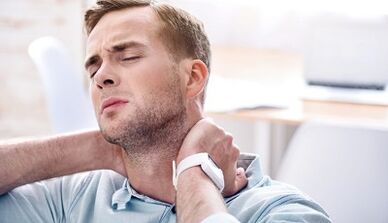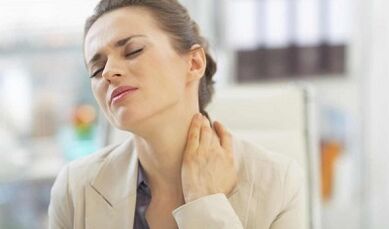
Pain in the neck muscles can be associated with different deviations.The underlying cause can be both diseases of the muscular system and violations in the work of the internal organs.
Ease of pain syndrome does not solve the problem: diagnosed pathologies should be adjusted in accordance with the adequate course of treatment.
Possible causes of neck pain
A large number of reasons that explain the appearance of neck pain is known.The source can be diseases of the muscular -skeletal system, damaged blood flow to the neck, vascular disease.
One of the most common causes of pain is spinal pathology.The neck can also damage due to the pathologies of the internal organs, infectious and viral processes.
Osteochondrosis
With osteochondrosis of the cervical spine, the neck hurts due to the thinning and deformation of the vertebral discs.These disorders lead to the formation of microcirculation in the beads, which provokes the growth of osteophytes and the appearance of a hernia.Pathological formations have a traumatic effect on the surrounding tissue and nerve endings, causing an inflammatory process.
With osteochondrosis of the cervical spine, the pain syndrome is located in the back of the neck.When you turn your neck, severe discomfort and cramp increase to pain.
Pain intensifies with head curves or sudden movements, cough or sneezing.As osteochondrosis develops, the pain spreads and reaches the shoulder and forearm areas.
Especially severe pain is done in the morning.There is also a stiffness of movements, the patient literally is unable to turn his head to the side.
Gradually, the pain becomes less pronounced, transformed from acute to stupid.
The sharp periites of pain in the cervical spine osteochondrosis are compared to a concussion - they are such and drilling shoots.
Also, with the disease shown, the following symptoms are observed:
- the weakness of the hands;
- headache;
- faint;
- dizziness;
- noise and bell in the ear;
- a sense of disorientation;
- insomnia;
- Emotional instability.
Myosite neck
Cervical myosite is inflammation of the neck muscles.The main symptom of this deviation is intense pain that can decrease or increase.The patient cannot turn his head, bend it forward or throw it back.
Most often, pain in myosite only lies on one side of the neck, but sometimes both can affect both at once.Pain is characterized by radiation in the upper body.
Also, with the inflammatory process of the neck muscles, the severity in the neck, swelling of the beads, is felt.Pain may occur in the head area, which gives the back of the head or temple.There are also difficulties in chewing and swallowing food.
As the pathological process develops, the temperature rises, a cough occurs, choking attacks.
Hernia of the cervical spinal column
This pathology is the result of the progression of osteochondrosis.It is very dangerous: in the cervical region there are a large number of nerve endings of the spinal cord.In addition, there are centers that are responsible for the flow of oxygen to the lungs.That is why hernia has attacks of headache, dizziness, drowning.

With a strong extension of a hernia, a person can kill.
If the hernia hit the discs in the space between the first and fourth vertebrae, then the pain is short -term, they are unexpected.With damage to the discs after the fourth vertebra, the pain is located in the shoulder area, after six - from the shoulder joint to the fingers of the upper extremities.
In addition to pain in the patient's neck, the patient is observed:
- a sense of weakness in their hands, their numbness;
- decreased head mobility;
- migraines;
- dizziness;
- Violation of visual acuity.
As the disease progresses, coordination of movements is concerned, a person becomes less stable.
Spondillartrosis
With spondylo arthritis of the cervical spine, inflammation of the facial joints is observed, due to which their structure is disturbed.In this case, the joints experience increased load and are damaged, which leads to the formation of osteophytes - bone growth that exerts pressure on the vessel and nerve roots.
With the spondylo arthrosis of the neck, short -term pain in the area, which are given to their hands, naps and shoulders, appear.The sensitivity in the neck also decreases, its movement after sleep is limited.In addition, patients mark the dizziness and ignition of the flies in front of their eyes.
The nature of the pain depends on the stage of spondylo arthrosis:
- In the first, it is practically missing: only with prolonged loads does a feeling of concern occur.
- In the second phase, acute pain is observed in the morning.
- In the third person feels the constant pain.
- In the fourth stage, the mobility of the affected joints is violated, and over time, provided that there is no adequate treatment, they are completely immobilized.
As the pathological process develops, additional symptoms appear: ears noise, numbness of cervical and shoulder areas, changes in blood pressure levels and violation of coordination of movements.
Bekhterev's disease (ankylosing spondylitis)
Bekhterev's disease is a chronic inflammatory process of the spine, which applies to joints and ligaments.With this disease, the inflammatory process initially affects the site of the bond of the sacrum and the iliac bone, then slowly spreads to the upper parts, exposing the entire column to degenerative changes.
Sometimes the process of developing the pathological process begins with the neck, namely the cervical radiculus.In this case, the patient feels a sharp abandonment from neck to hand.
With ankylosing spondylitis, the rigidity of the spinal column is observed, limiting the movement of the chest and loss of flexibility with the spine.The spinal column is curved in the chest and Lumbar region.In this case, the "speaker's pose" is noticed.
The disease progresses slowly, so it remains unnoticed for a long time.
Tuberculosis
Spinal column tuberculosis can affect any of its departments, while the cervix at the smallest degree is subject to this disease.However, such a pathology is still found (in 5% of cases).
The symptoms in this case are:
- Severe, persistent pain in the neck muscles;
- swelling of the affected area, increasing constantly in size;
- sore throat;
- cough;
- Hard swallowing.
Pain syndrome with cervical back tuberculosis is very strong.The patient tries not to move his head, as this causes him great suffering.In this case, absolutely all muscles are injured, including deep muscle layers.
Cervical department tumor neoplasms
Tumors in the cervical spine occur quite rarely, but metastases from the tumors often penetrate the area, which are located in the kidneys, mammals.
With tumors in the neck, the patient experiences pronounced pain that becomes more intense as the pathological process progresses.

In addition, symptoms such as:
- weakness in muscle;
- muscle cramps;
- numbness;
- headache;
- dizziness;
- difficulty swallowing;
- insomnia;
- Business States that turn to pallor;
- Abundant separation of cold sweat.
Tumors that are localized high in the neck affect the brain.This causes the symptoms of a neurological nature mentioned in the list.
Meningitis
The neck muscles are often injured in the case of meningitis.This is an inflammatory process that affects the shells of the brain or spinal cord.In this case, a spasm of the muscle fibers of the occipital part of the head occurs.
With meningitis, a person feels dull pain in the neck, cannot lie on his back in the usual position.
Also, with meningitis, such characteristic traits arise:
- constant headaches in which there is a sensation of the explosion of the kranit box from the inside;
- convulsions of upper and lower extremities;
- hallucinations;
- unmotivated aggression;
- increase in body temperature;
- nausea and vomiting;
- the inability to perceive a bright color;
- Violation of consciousness.
Thyroid
Thyroid gland dysfunctions affect the patient's overall well -being and cause a variety of characteristic symptoms.
This part of the endocrine system is located in the throat area, so its inflammation or lesion of another nature causes pain in the neck.A similar symptom occurs with hyperthyroidism, hypothyroidism, thyroiditis, development of a thyroid goiter.The appearance of pain is due to an increase in the size of the gland as well as hormonal disorders in the body.
With these diseases, the pain is of a truly regular character and localizes to the front of the neck.Pain can be given to the occipital area, an ear area.Tiningling can also be observed periodically.
Additional symptoms:
- feeling of heat;
- increased sweating;
- heartbeat;
- drowsiness.
Neuralgia
The neuralgia of the cervical spine is a violation of the nerve roots associated with a violation of the structure of the intervertebral disc.

Cervical neuralgia is associated with such symptoms:
- Neck pain, which suddenly occurs when you turn your head, touching the place near the occipital nerve.In the initial stage of development of pathology, the pain is located at the bottom of the neck, the back of the head, and then extends to the area of the eye.The nature of the pain is acute painful sensations that resemble an electric shock.
- Increased photosensitivity.
- Pain of the scalp.
- One -sided headache that is constant pain.
- Blood pressure.
- Heat, chills.
- Trembling hands.
Neck pain can be due to high emotional stress, increased physical exercise.
Which doctor to contact with?
The appearance of regular neck pain, which have a pronounced character and radiate to individual areas of the body, is a case to see a doctor.
First of all, you should visit the therapist, who, after analyzing the main symptoms, will determine which specialist will require in a special case.
Setting the causes that caused neck pain, as well as the treatment of the pathologies in which it occurs, is engaged in such specialist specialists:
- Neurologist.This specialist is engaged in diseases in which the cervical nerve has occurred or spinal cord damage.The neurologist is engaged in cases where neck pain is associated with migraines, dizziness and convulsions.
- Traumatologist.The doctor is engaged in cases where the pain is caused by injuries.
- Vertebologist.The specialist regulates the patient's condition in the event of damaged functions of the muscular-skeletal-breed-breed-spondylitis system.
- Orthopedic.To consult this doctor with pathologies such as cartilage thinning, scoliosis, osteoporosis.
- Osteopath.This specialist is treating patients suffering from degenerative changes in the joints and beads.Osteopathy treats osteochondrosis, is engaged in correcting the patient's behavior.
- Rheumatologist.The doctor is engaged in cases of damage to muscle tissue and bone - rheumatism, arthritis.
In addition to these experts, the help of a manual therapist, physiotherapist, massur may be required.
Diagnostic methods
With pain in the neck muscles, such diagnostic measures are described as:
- Anamnesis collection;
- visual inspection;
- Check the sensitivity of the affected area as well as its mobility;
- blood and urine tests;
- X -Comalization of the cervical spine;
- MRI;
- Ct;
- Electromography.
Based on the results of the diagnosis, the specialist determines the cause of neck pain and describes adequate treatment.
What to do if the neck hurts: approaches to treatment
A specific disease is treated according to a particular scheme.It all depends on the root cause of the pain syndrome, but we can distinguish the main approaches to eliminate unpleasant sensations.
Drug therapy
Often, neck pain becomes very severe.To suppress his severity, the patient is the prescribed medicine.In this case, the following medicines are appropriate:
- anti -inflammatory drugs in the form of tablets;
- Musorelaxants - soothing soothing that relieves spasm;
- Analgesics used to worsen diseases.
In diseases that cause neck pain and the stirring processes of cartilage and bone tissue, chondroprotectors are required - medicines that positively affect its restoration processes, and also have an anesthetic effect.
Also, patients with neck pain are drugs that normalize metabolic processes in the affected tissue.
Physiotherapy

If the neck muscles are injured due to degenerative spine processes, such physiotherapeutic procedures have been described:
- Diadinamotherapy- Impact on areas affected with current dual waves;
- balneotherapy- measures related to water procedures;
- electropathy- exposure to electricity in the affected areas;
- Magnetotherapy- exposure to magnetic fields to injured sections of the cervical region;
- Laser therapy- laser exposure.
Physiotherapeutic procedures are not performed in the event of a general serious condition of the patient, during the period of deterioration of osteochondrosis, with mental disorders, impaired skin integrity at the site of the claimed effect.
The auxiliary methods listed not only contribute to a decrease in pain intensity, but also strengthen immunity, restore complete blood circulation in the affected areas and reduce the severity of muscle system disorders.
Massage
In case of pain, located in the neck, it can also be included in the complex therapy of the massage procedure.They are performed by a specialist, as the wrong access can cause additional damage to bone and muscle structures.
Neck massage, which relaxes its muscles, is performed in a sitting or stretched position.The effect is exerted on the trapezoid muscles that support the cervical vertebrae.
Initially, the specialist makes light movements in the bottom hit.After heating techniques, the area of special processes is rubbed.Next, rubbing the back surface of the neck, vibrating exposure.
The massage session lasts from 3 to 10 minutes.
Surgical intervention
Pain with neck pain may be required if there are such pathologies:
- Intervertebral disc hernia;
- compression of spinal roots, or radiculopathy;
- compression of the spinal cord, or myelopathy.
The surgery on the cervical spine is aimed at removing sections of vertebrae that have a traumatic effect on the spinal cord.
Currently, classic operations that require a long period of rehabilitation are replacing less invasive methods:
- Endoscopy, in which the intervention is performed through a puncture;
- Microsurgical operations that allow you to remove hernias without damaging the surrounding tissue of the spinal cord.
Folk remedies
In case of neck pain, you can try to calm it down with the help of popular remedies.The most effective are:
- Compresses with horseradish.The horseradish leaf should be rinsed with boiling water, let it cool to a comfortable temperature, glue it to the neck.Wrap the scarf at the top.You need to apply compression before bedtime and leave it all night.If there is a strong burning sensation, you should remove the compression and rinse the skin with warm water.
- Compress with laurel oil.10 drops of oil should be diluted in 1 liter of warm water.Dip the tissue in the juice and combine in the neck for 20-30 minutes.
- Lubrication of the affected area with honey.After applying it, you should press the processed place with your palms tightly, and then coat it harshly.Repeat until the honey is completely absorbed.
General recommendations
In diseases that cause severe pain in the cervical spine, you should pay attention to the following recommendations:
- It is necessary to keep your behavior properly when you sit down and when you walk.
- When pain in the cervical region occurs during physical exercise, it is worth stopping their application, let the muscles rest.In the future, the load rate should be reviewed by which the neck area is subject.
- It is necessary to dedicate the time of physical exercise regularly, at least not very intense.For the health of the spine, swimming, yoga are useful.
- It is recommended to prioritize a backpack, not a bag: it gives a uniform load on the left and right parts of the body.
- It is useful to take a contrast shower.Alternating temperatures positively affects the bloodstream, does not allow blood and lymph to stagnate.
The same recommendations can be used as a prevention.
The neck muscles can damage due to different pathologies of the spinal column, somehow less painful syndrome is due to the pathologies of the internal organs.The treatment regimen depends on the reason diagnosed by a physician after a comprehensive examination.


























